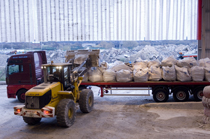
Results of recent recyclable gypsum waste meeting revealed
Both the construction and demolition sectors produce lots of plasterboard waste which can be recycled
Eurogypsum recently hosted a meeting in Brussels, which offered recyclers and producers the opportunity to share their views.
The meeting was attended by UK board and plaster manufacturer, Roy Hatfield.
German gypsum recycling plant, MUEG, and French waste recovery and recycling specialist, Nantet Locabennes also made an appearance.
The meeting featured a review of Europe’s Waste Framework Directive, where a focus was placed on the European Commission’s drive towards a Circular Economy and zero waste programme.
Issues such as the effective implementation of waste regulations and the acceptance criteria to the role of gypsum waste collectors were discussed.
Debates were also centred around the definition of recyclable gypsum waste (RGW), avoiding cross-contamination and ensuring the quality of recycled gypsum.
The definition of RGW
The meeting’s attendees agreed that the definition of RGW depends on the recyclers and their treatment techniques and customer requirements.
The country in which they operate from also has an impact.
Contaminated gypsum was defined as limiting factor as any trace of asbestos prohibits recycling.
Pre-sorting was suggested as an expensive solution.
Most of those at the meeting agreed that achieving end-of-waste status improves the image and potential value of recycled material.
Results of the meeting
The meeting demonstrated how producers and recyclers are prepared to work together to enhance resource efficiency opportunities within the building sector.
Gypsum Products Development Association (GPDA),
PO Box 35084,
London,
United Kingdom,
NW1 4XE
Phone: 0207 9358532
Visit Gypsum Products Development Association's website
Visit Supplier's page
Latest news

28th February 2025
Passivent ventilation solutions are top of the class
Passivent has supplied a combination of Hybrid Plus2 Aircool ventilators and Hybrid Plus Airstract roof ventilation terminals for a new London primary school.
Posted in Air Conditioning, Articles, Building Industry News, Building Products & Structures, Building Services, Case Studies, Ceilings, Facility Management & Building Services, Heating, Ventilation and Air Conditioning - HVAC, Restoration & Refurbishment, Retrofit & Renovation, Roofs, Sustainability & Energy Efficiency, Ventilation, Walls
28th February 2025
Troldtekt: New acoustic liner ensures good acoustics and easy handling
Both a building’s users and its developers have a good reason to get excited about the new Troldtekt Plus 25 panels. This specially developed acoustic panel sets a high standard for both sound absorption and building efficiency.
Posted in Acoustics, Noise & Vibration Control, Articles, Building Industry News, Building Products & Structures, Building Services, Building Systems, Ceilings, Facility Management & Building Services, Floors, Innovations & New Products, Insulation, Interior Design & Construction, Interiors, Restoration & Refurbishment, Retrofit & Renovation, Timber Buildings and Timber Products, Walls
28th February 2025
InstallerSHOW 2025 – Registration is now OPEN!
Building on the success of last year, InstallerSHOW is returning to the NEC from the 24th to the 26th of June…
Posted in Articles, Building Industry Events, Building Industry News, Building Products & Structures, Building Services, Exhibitions and Conferences, Health & Safety, Retrofit & Renovation, Seminars, Sustainability & Energy Efficiency
28th February 2025
ABLOY securing Helsinki’s heritage and Croatia’s waste management
ABLOY, part of ASSA ABLOY Group, has redefined its brand, focusing on the value it brings to customers around the world…
Posted in Access Control & Door Entry Systems, Architectural Ironmongery, Articles, Building Industry News, Building Products & Structures, Building Services, Case Studies, Doors, Facility Management & Building Services, Health & Safety, Retrofit & Renovation, Security and Fire Protection
 Sign up:
Sign up: